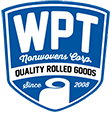
Not surprisingly, the use of nonwovens for medical purposes goes all the way back to WWII, which precipitated a big demand for easily-deployed medical products. As the technology gradually improved, nonwovens proved to be superior to woven products in terms of disposability, adaptability, effectiveness, and cost.
Ubiquitous cross-contamination and nosocomial infections in hospitals made it clear that the re-use of masks and gowns was largely to blame. In addition to making it possible to dispose of potentially contaminated items, nonwovens provided effective barriers against bacteria; they were also better than linens for air-borne contamination reduction.
In fact, the disposable woven products industry is poised to reach a whopping $20,000,000,000 by 2017. The global diabetes, obesity, and cancer pandemics (as well as a growing aging population) may partly account for this growth but the most salient reason is the fact that nonwovens are intrinsically indispensable to the ever-evolving medical textile industry.
Beyond the reasons already given, nonwoven fabrics will dominate this industry because nonwovens:
- Help mitigate the today-riskier medical environments due to drug-resistant bacteria, increases in numbers of blood-borne diseases, worsening viral threats, highly-polluted indoor/outdoor air, etc.
- Can be tailored to changing specifications
- Can meet increasing demands for more environmentally-responsible/friendly disposable products
- Have almost limitless applications for healthcare products: surgical gowns; bedding; dressings; surgical drapes; implantables like sutures, orthopedic & tissue structures, etc.
Use of Nonwovens in Medical Textiles
Beyond the now-rather-long list products nonwovens make possible, there are perhaps-less-well-known uses, such as in artificial liver, heart, kidney, & mechanical lungs, vascular grafts, ligaments, blood vessels, heart valves, and artificial skin.
But even most astounding are the uses that will become possible in the foreseeable future. Natural fibers, for example, combined with biodegradable polymers will be used in the development of exciting new medical textile products.
Because lives are at stake, nonwoven medical textile technology is being subjected to intense monitoring—it’s this intense scrutiny that has raised the bar on quality and is opening doors for new uses within the industry that were merely dreamed of not too long ago.
Things like tissue bioengineering, nanotechnology, and the ever-expanding science of bio-materials are literally opening new horizons in the medical textile and related industries. Nonwovens are one of the many exciting catalysts for these promising technological developments.
Most people know that disposable incontinence/personal hygiene products are increasingly important products but what about the use of nonwoven technology to repair/replace bones, organs, vascular systems and skin grafts?
Simply put, nonwoven technology has greatly improved the life of many individuals with the use of the relatively new exciting field of biomedical textiles.
Here are just a few of the controllable properties of nonwovens that make them ideal for medical applications:
- Porosity
- Fabric weight
- Thickness
- Sterilization capacity/ease-of
- Limitless manufacturing customization
- Cost-effectiveness
Why Nonwovens for Medical Applications?
Nonwoven have a well-established reputation for conforming to the special needs/demands of medical settings, thanks to the following characteristics:
–Uncanny effectiveness/efficiency
–High performance (vapor transmission, air permeability, comfort, feel, etc.)
–Superior barrier-providing capacity
–Excellent user protection (high tearing & abrasion resistance, etc.)
–Good cross-contamination control
–Unbeatable wound-caring (absorbent pads, drug-delivery devices, bandages, etc.)
–Well-documented usage in ICUs, labs, operating rooms, etc.
Medical Device Implants
One of the most impressive uses of nonwovens is in implantables, made possible by their:
- Control of permeability
- Good tissue-growth
- Low-parameter elongation
- Good absorbency
Obvious Benefits & Suitability of Medical Applications
Nonwovens have effectively replaced more traditional barrier-rendering and aseptic medical fabrics (e.g., linens).
Out-of-body-usage nonwovens are single-use, disposable products not requiring re-cleaning or sterilization; disposable nonwovens come sterilized and help eliminate contamination.
Nonwovens can be manufactured using eco-friendly, natural fibers.
Nonwovens often use cotton, which has many wonderful applications/properties for medical settings (e.g., hypoallergenic, naturally absorbent, soft, etc.)
New bio-polymer substances (e.g., polyactide or PLA) are another plausible biodegradable, recyclable and renewable alternative to synthetic fibers
Conclusion
Nonwoven medical textiles have become indispensably important in surgery and medicine; the range of uses for this material is a testament to its incredible versatility and adaptability. The products made possible by this technology may appear to be the realm of the technologically knowledgeable.
But that perception belies the fact that everyone, at one point or another, will benefit from this technology. Nonwoven medical textiles, therefore, aren’t just something for the medical industry to appreciate but, rather, something everyone needs to be openly thankful for and appreciative of.

